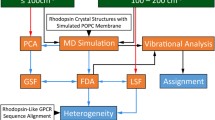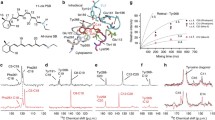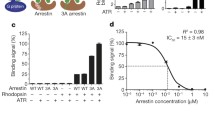Abstract
X-ray and magnetic resonance approaches, though central to studies of G protein–coupled receptor (GPCR)-mediated signaling, cannot address GPCR protein dynamics or plasticity. Here we show that solid-state 2H NMR relaxation elucidates picosecond-to-nanosecond–timescale motions of the retinal ligand that influence larger-scale functional dynamics of rhodopsin in membranes. We propose a multiscale activation mechanism whereby retinal initiates collective helix fluctuations in the meta I–meta II equilibrium on the microsecond-to-millisecond timescale.



Similar content being viewed by others
Accession codes
References
Kobilka, B. & Schertler, G.F.X. Trends Pharmacol. Sci. 29, 79–83 (2008).
Ahuja, S. & Smith, S.O. Trends Pharmacol. Sci. 30, 494–502 (2009).
Okada, T. et al. J. Mol. Biol. 342, 571–583 (2004).
Ridge, K.D. & Palczewski, K. J. Biol. Chem. 282, 9297–9301 (2007).
Brown, M.F. J. Chem. Phys. 77, 1576–1599 (1982).
Altenbach, C., Kusnetzow, A.K., Ernst, O.P., Hofmann, K.P. & Hubbell, W.L. Proc. Natl. Acad. Sci. USA 105, 7439–7444 (2008).
Ahuja, S. et al. J. Biol. Chem. 284, 10190–10201 (2009).
Frauenfelder, H. et al. Proc. Natl. Acad. Sci. USA 106, 5129–5134 (2009).
Vogel, R. et al. Biochemistry 45, 1640–1652 (2006).
Knierim, B., Hofmann, K.P., Ernst, O.P. & Hubbell, W.L. Proc. Natl. Acad. Sci. USA 104, 20290–20295 (2007).
Mahalingam, M., Martínez-Mayorga, K., Brown, M.F. & Vogel, R. Proc. Natl. Acad. Sci. USA 105, 17795–17800 (2008).
Struts, A.V. et al. J. Mol. Biol. 372, 50–66 (2007).
Brown, M.F. Chem. Phys. Lipids 73, 159–180 (1994).
Verdegem, P.J.E., Bovee-Geurts, P.H.M., de Grip, W.J., Lugtenburg, J. & de Groot, H.J.M. Biochemistry 38, 11316–11324 (1999).
Spooner, P.J.R. et al. Biochemistry 42, 13371–13378 (2003).
Kukura, P., McCamant, D.W., Yoon, S., Wandschneider, D.B. & Mathies, R.A. Science 310, 1006–1009 (2005).
Copié, V. et al. Biochemistry 33, 3280–3286 (1994).
Borhan, B., Souto, M.L., Imai, H., Shichida, Y. & Nakanishi, K. Science 288, 2209–2212 (2000).
Park, J.H., Scheerer, P., Hofmann, K.P., Choe, H.-W. & Ernst, O.P. Nature 454, 183–188 (2008).
Ernst, O.P., Gramse, V., Kolbe, M., Hofmann, K.P. & Heck, M. Proc. Natl. Acad. Sci. USA 104, 10859–10864 (2007).
Acknowledgements
We thank T.A. Cross, K.P. Hofmann, M. Hong, W.L. Hubbell, L.E. Kay, S.O. Smith and R.W. Pastor for discussions. Retinal was provided by K. Tanaka, S. Krane and K. Nakanishi (Columbia University). Financial support from the US National Institutes of Health (EY012049 and EY018891) is gratefully acknowledged.
Author information
Authors and Affiliations
Contributions
A.V.S. and M.F.B. designed the research. A.V.S. and G.F.J.S. performed the experiments. A.V.S., G.F.J.S., and K.M.-M. analyzed the data. A.V.S. and M.F.B. wrote the paper.
Corresponding author
Ethics declarations
Competing interests
The authors declare no competing financial interests.
Supplementary information
Supplementary Text and Figures
Supplementary Methods and Supplementary Figures 1 and 2 (PDF 3111 kb)
Rights and permissions
About this article
Cite this article
Struts, A., Salgado, G., Martínez-Mayorga, K. et al. Retinal dynamics underlie its switch from inverse agonist to agonist during rhodopsin activation. Nat Struct Mol Biol 18, 392–394 (2011). https://doi.org/10.1038/nsmb.1982
Received:
Accepted:
Published:
Issue Date:
DOI: https://doi.org/10.1038/nsmb.1982
- Springer Nature America, Inc.
This article is cited by
-
Strategies for acquisition of resonance assignment spectra of highly dynamic membrane proteins: a GPCR case study
Journal of Biomolecular NMR (2023)
-
Vibrational resonance, allostery, and activation in rhodopsin-like G protein-coupled receptors
Scientific Reports (2016)





